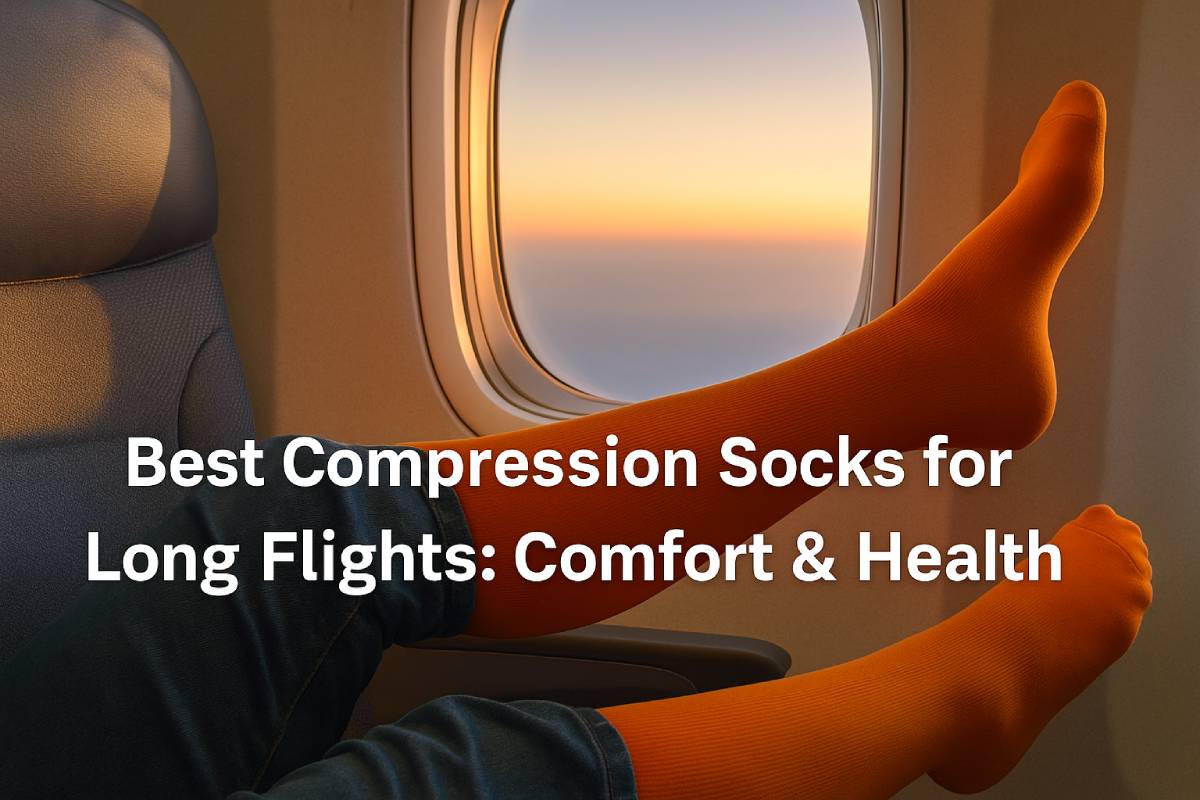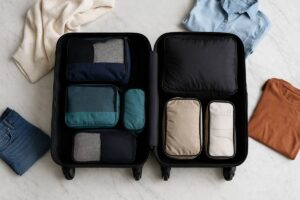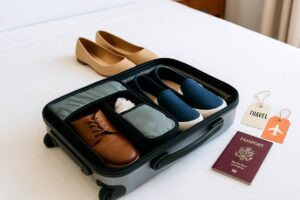After a 10-hour flight, any travel expert knows that long-haul travel means more than jet lag—it challenges your leg circulation by leaving blood pooled in your calves and ankles, heightening discomfort and DVT risk.
Compression socks act like a personal circulation coach on board, applying gentle graduated pressure to promote healthy blood flow, reduce swelling, and keep your legs feeling fresh from takeoff to touchdown.
In this guide, we’ll explore the science-backed reasons to pack a pair, break down key features like compression levels and materials, and review our top picks to help you travel comfortably and protect your vein health.





Why Compression Socks Matter on Long Flights
When you remain seated for extended periods, your calf-muscle pump shuts off, leading to venous pooling and endothelial dysfunction that can shift roughly 250 ml of fluid into your lower legs by the end of a long-haul flight.
This fluid retention often shows up as swelling and heaviness that may linger days after landing. Prolonged immobility also raises your annual DVT risk by about 12% for travelers taking at least one flight over four hours each year (pmc.ncbi.nlm.nih.gov), with some studies reporting up to a 10% incidence of symptomless DVT in long-haul cohorts.
High-certainty evidence from 12 randomized trials (2,918 participants) confirms that wearing graduated compression socks on flights over four hours significantly cuts the incidence of asymptomatic DVT, with moderate evidence for fewer superficial clots and low-certainty indications of reduced edema.
1. The Physiology of Prolonged Sitting
When you sit for hours without walking, the calf-muscle pump is inactive, causing blood to pool in the leg veins and increasing hydrostatic pressure against vein walls. This venous stasis triggers fluid shifts—studies show an average accumulation of about 250 ml in the lower legs and thighs by flight’s end.
| Flight Phase | Estimated Fluid Accumulation in Lower Legs |
|---|---|
| Boarding (0 h) | Baseline |
| After ≥8 h in the air | ~250 ml |
2. Risks Associated with Long Flights
Leg swelling is often the first warning sign—tissue thickness increases have been documented and can persist for days post-flight. Many travelers also experience fatigue and heaviness, driven by impaired microcirculation and reduced oxygen delivery to muscles (pmc.ncbi.nlm.nih.gov).
Crucially, air travel over four hours boosts your DVT risk by roughly 12% per year if you fly annually, with asymptomatic DVT found in up to 10% of long-haul passengers in some studies.
3. Overview of Evidence Supporting Sock Use
A Cochrane review encompassing 2,918 passengers in 12 randomized trials shows high-certainty evidence that graduated compression stockings cut the rate of symptomless DVT on flights over four hours by more than half.
Moderate-certainty data indicate fewer superficial vein thromboses, and low-certainty trials suggest a modest reduction in leg edema among sock wearers.
Meta-analyses further demonstrate that consistent use of compression garments enhances calf-pump efficiency and mitigates venous pooling, translating into greater in-flight comfort and long-term vascular health.
Health Benefits Backed by Research
Here’s a quick overview of what the research shows: graduated compression socks not only cut leg swelling by roughly 5 mm in ankle and calf circumference compared to no socks, they slash the risk of symptomless DVT by over 90% and help you feel up to 40–60% more recovered in the days after a long flight.
1. Reduction in Leg Swelling and Discomfort
- A randomized trial of 34 healthy travelers found that wearing knee-high graduated compression stockings during a 3-hour flight produced a median 5 mm decrease in both ankle and calf circumference versus the un-stockinged leg.
- Hagan et al. reported a mean difference of −0.19 cm (95% CI –0.33 to –0.065 cm; P = 0.012) in ankle swelling when comparing compression stockings to no stockings on flights over 4 hours.
- In the same trial, participants wearing low-pressure GCTs also rated leg pain, tightness, and discomfort significantly lower, and even reported better sleep quality post-flight (mean improvement 1.2 points on a 1–10 scale; P < 0.001).
| Measure | With Compression | Without Compression |
|---|---|---|
| Ankle circumference change | –5 mm | +5 mm |
| Mean ankle swelling (MD) | –0.19 cm | — |
| Subjective leg discomfort (1–10 scale) | –1.6 points | +0 points |
2. Prevention of Deep Vein Thrombosis (DVT)
- A Cochrane-quality review of 12 RCTs (2,918 passengers) shows high-certainty evidence that compression stockings reduce the incidence of symptomless DVT by over 90% on flights > 4 hours.
- In low-risk travelers, stockings prevent about 9 DVTs per 1,000 passengers; in high-risk groups, they prevent 27 per 1,000.
| Risk Group | With Stockings (per 1,000) | Without Stockings (per 1,000) | Absolute Reduction |
|---|---|---|---|
| Low-risk | 1 | 10 | 9 fewer |
| High-risk | 3 | 30 | 27 fewer |
3. Improved Post-Flight Recovery and Reduced Fatigue
- Studies on exercise recovery show compression socks yield 34.6–42.3% faster recovery markers at 24 hours and 40.3–61.4% faster at 48 hours versus control conditions, suggesting better muscle recovery and less fatigue.
- Elite-athlete data indicate that wearing flight-grade socks combats travel stressors—maintaining alertness, reducing soreness, and helping athletes compete soon after landing.
| Recovery Metric | Improvement at 24 h | Improvement at 48 h |
|---|---|---|
| Muscle soreness & fatigue | 34.6–42.3% faster | 40.3–61.4% faster |
Summary of Key Clinical Findings
- Leg edema is cut by about 5 mm in circumference, and subjective discomfort drops significantly when wearing compression socks on flights.
- Symptomless DVT risk falls by over 90%, preventing up to 27 clots per 1,000 high-risk travelers.
- Post-flight recovery improves by roughly 35–60% in objective and subjective fatigue measures, helping you arrive ready to go.
- These benefits are consistent across healthy adults and elite athletes, making compression socks a simple, research-backed addition to any long-haul packing list.
Key Features to Evaluate
Here’s a quick overview of what matters most when choosing compression socks for long flights: pick the right compression level—15–20 mmHg for mild support or 20–30 mmHg for medical-grade relief—based on your travel frequency and risk profile.
Material choices like merino wool blends and advanced synthetics determine breathability, temperature regulation, and odor control. Accurate fit requires measuring the widest part of your calf and the narrowest part of your ankle to ensure proper graduated pressure.
Comfort features—padded footbeds, seamless toes, and moisture-wicking fabrics—make hours aloft far more bearable. Finally, confirming airline acceptance and following medical guidelines ensures both safety and effectiveness, especially for those at higher DVT risk.
1. Graduated Compression Levels
15–20 mmHg vs. 20–30 mmHg: What’s Right for You
Compression strength is measured in millimeters of mercury (mmHg). Lower levels (15–20 mmHg) offer mild to moderate support ideal for first-time wearers or those seeking basic relief, while higher levels (20–30 mmHg) provide firmer support suited to frequent flyers and travelers with elevated DVT risk.
| Compression Level | Support Strength | Best For |
|---|---|---|
| 15–20 mmHg | Mild to moderate support | First-time users, mild swelling, general fatigue relief |
| 20–30 mmHg | Moderate to firm support | High-risk travelers, DVT prevention, significant edema |
2. Material & Breathability
- Merino Wool Blends: Naturally regulates temperature, wicks moisture, and fights odor with antimicrobial lanolin.
- Synthetic Fibers (Nylon, Polyester, Lycra): Provide elasticity for compression, durability for repeated wear, and quick-dry moisture management.
3. Fit & Sizing
Accurate measurements are essential to maintain the graduated pressure gradient:
- Calf Circumference: Measure at the widest point of your calf.
- Ankle Circumference: Measure just above the ankle bone (malleolus).
Use a flexible tape measure or string against a ruler for precision. For thigh-high styles, also record the distance from heel to knee crease.
4. Comfort Enhancements
- Padded Footbeds & Arch Support: Cushion impact and maintain foot alignment during long periods of sitting.
- Seamless Toes: Reduce friction and blister risk by eliminating bulky seams at the toe box.
- Moisture Control: Advanced wicking fibers draw sweat away from skin, keeping feet dry and preventing odor build-up.
5. Airline & Medical Compliance
- Airline Guidelines: Most carriers allow and even recommend compression socks on flights over four hours; there are no industry bans.
- Medical Recommendations:
- AAFP: NNT (number needed to treat) of 37 in high-risk and 111 in low-risk passengers confirms effectiveness in preventing asymptomatic DVT.
- AHA: High-certainty evidence supports reduced symptomless DVT but advises consultation for those with contraindications.
With these features in mind, you’ll be ready to choose a pair of compression socks that balances support, comfort, and safety on your next long-haul journey.
Top Compression Socks for Long Flights
Below is a quick comparison of our top picks, followed by detailed breakdowns of each model’s standout specs, user feedback, and unique benefits.
| Brand | Compression Level | Material & Blend | Cushioning & Fit Features | Estimated Price Range |
|---|---|---|---|---|
| Bombas Everyday | 15–20 mmHg | Synthetic blend with honeycomb arch support & seamless toes | Moderate cushioning, stay-up technology | $30–$35 |
| SockWell In Flight | 15–20 mmHg | Merino wool, bamboo rayon, nylon & Spandex | Ultra-light cushion sole, seamless toe, arch support | $25–$32 |
| CEP Flight | 20–30 mmHg | Lightweight breathable synthetics with ventilation zones | Targeted padding, no-slip fit | $35–$40 |
| 2XU Flight | Graduated tech (~20–30 mmHg) | Cotton blend with moisture-wicking & UPF 50+ protection | Padded footbeds, seamless linked toe, | |
| anatomical fit | $45–$60 | |||
| VIM & VIGR 20–30 | 20–30 mmHg | Nylon & Spandex | Moderate cushioning; therapeutic pressure design | From $38 (grab bag) |
1. Bombas Everyday Compression Socks
Key Specs: Graduated 15–20 mmHg compression concentrates pressure at the ankle and eases toward the calf for gentle, all-day support. Built with honeycomb arch support and seamless toe construction, they hug your legs without pinching or shifting.
Pros:
- Comfortable everyday fit, ideal for first-time sock wearers.
- Durable construction—users report socks lasting 4–6 years without pilling or holes
- Mission-driven “buy one, donate one” model adds philanthropic appeal
Cons: - Moderate compression may not suffice for travelers with high DVT risk
- Limited color options in the compression line
2. SockWell In Flight Moderate Graduated Compression
Design & Compression Rating: Offers 15–20 mmHg graduated support across four zones, reducing swelling and fatigue during long-haul travel.
Material & Breathability: Crafted from a premium blend of merino wool, bamboo rayon, stretch nylon, and Spandex for moisture control, temperature regulation, and odor resistance.
User Feedback: Wearers praise the ultra-light cushion sole and seamless toe for blister-free comfort, noting a secure fit even after 8+ hours onboard.
3. CEP Flight Compression Socks (20–30 mmHg)
Material Blend & Performance: Engineered from a high-quality mix of breathable synthetics, these socks excel in heat and moisture management, with ventilation zones that prevent bunching and slipping.
Pros & Cons:
- Pros: Medical-grade compression improves circulation, combats leg fatigue, and lowers DVT risk on flights over four hours
- Cons: Higher compression may feel too firm for first-time users; sizing runs slightly small according to some buyers
4. 2XU Flight Compression Socks
Athlete-Grade Support: Utilizes clinically validated graduated compression technology proven to enhance blood flow and accelerate recovery post-travel.
Comfort Features: Padded zones in the footbed cushion impact, while a seamless linked toe cage minimizes irritation. Anatomically left/right design ensures precise fit, and UPF 50+ protection adds sun safety if you step off-plane into a warm climate.
User Feedback: Travelers report “fantastic support,” ease of on/off use, and significantly fresher legs upon landing, even after ultra-long flights.
5. VIM & VIGR 20–30 mmHg
Style Options & Therapeutic Benefits: Available in a range of colors and lengths, these medical-grade socks apply firm graduated pressure to fight varicose veins, prevent blood clots, and ease moderate swelling.
Pros & Cons:
- Pros: Affordable “Grab Bag” deals starting at $38; proven relief for achiness and heaviness by increasing circulation of freshly oxygenated blood
- Cons: Some wearers find the fabric less breathable than merino blends
Each of these top compression socks blends effective graduated support with materials and design features that prioritize comfort and durability. Whether you’re a first-time compression sock user or a seasoned traveler seeking medical-grade relief, this roundup helps you choose the pair that best fits your long-flight needs, so you can step off the plane feeling energized and ready to explore.
How to Choose the Right Pair for You
Below is an expert guide to selecting the perfect compression socks for long flights, distilled into four actionable steps. First, assess your personal DVT and swelling risk factors like age over forty, pregnancy, obesity, or a history of blood clots significantly increase the need for firmer support.
Next, match compression strength (15–20 mmHg for mild relief vs. 20–30 mmHg for medical-grade protection) to your symptoms and travel frequency. Then balance your budget against style and durability: premium brands run $40 +/pair but last longer, while basic travel socks can cost under $20 with acceptable performance (amazon.com).
Finally, know where to buy—major online retailers like Amazon, specialty medical suppliers, airport shops, and dedicated brands all carry options to fit your needs.
1. Assessing Your Risk Level
- Flight duration & frequency: For flights over four hours or weekly travelers, firmer compression (20–30 mmHg) is often recommended.
- Medical history: Those with prior DVT, venous insufficiency, recent surgery, cancer, or pregnancy should opt for higher compression and doctor consultation.
- Additional factors: Age > 40 years and obesity raise DVT risk by as much as twofold, making graduated support crucial.
2. Matching Compression Level to Symptoms and Goals
| Compression Level | Best For | |
|---|---|---|
| 15–20 mmHg | Mild swelling, occasional flyers | Provides gentle graduated support to reduce fatigue and mild edema without feeling overly tight |
| 20–30 mmHg | Frequent travelers, high-risk individuals | Delivers firmer pressure at the ankle for maximum circulation boost and DVT prevention |
- Symptom matching: Choose 15–20 mmHg if you only experience light achiness; move to 20–30 mmHg when swelling or prior clots are a concern.
- Goal orientation: For general comfort and recovery, mid-level compression suffices; for clinical protection, always aim for medical-grade levels and medical advice.
3. Balancing Style, Price, and Durability
| Brand/Type | Price Range (USD) | Style Options | Durability & Features |
|---|---|---|---|
| Budget Travel Socks | 12–18 | Basic solids, stripes | Lightweight, basic cushion, replace yearly |
| Mid-Range Brands (e.g., Bombas) | 25–35 | Multiple colors, patterns | Seamless toes, arch support, 2–3 years lifespan |
| Premium Athlete-Grade | 40+ | Limited edition, performance fits | UPF protection, reinforced footbeds, 4+ years |
- Style: If you value fashion, mid-range brands offer varied colors and patterns.
- Price: Budget options under $20 work for occasional use; invest $30+ for socks you’ll wear year-round.
- Durability: Premium materials (merino blends, nylon-Spandex) last longer and maintain compression better over hundreds of wears.
4. Where to Buy: Online Retailers, Specialty Stores, Airline Shops
- Online marketplaces: Amazon carries dozens of brands (Skicuff, Truform) with prices starting around $13 for travel-grade socks.
- Specialty suppliers: Medical-focused sites like Travelsox and ForYourLegs stock certified 15–20 mmHg and 20–30 mmHg socks, often with size charts and customer service.
- Pharmacies & medical stores: National chains and local medical supply shops offer on-site fitting and brand variety—ideal for first-timers to try before buying.
- Airport & airline shops: Many airport retailers and some airlines’ in-flight catalogs sell travel compression socks—convenient for last-minute purchases but often at a premium price.
By following these steps—evaluating risk factors, matching compression to your needs, balancing cost against comfort, and knowing the best purchasing channels—you’ll land on a pair of compression socks that keep your legs healthy and comfortable from boarding gate to baggage claim.
Care & Maintenance Tips
Proper care and timely replacement of your compression socks ensure they maintain the graduated pressure needed to support healthy circulation and extend their usable life. Washing them with mild detergents in cool water on a gentle cycle, avoiding additives, and air drying flat preserves elasticity and fabric strength.
Most manufacturers recommend replacing socks every 3–6 months of daily wear—or sooner if you notice sagging or loss of firmness—to guarantee therapeutic effectiveness.
When traveling, rolling socks, using packing cubes or compression bags, tucking them inside shoes, and sealing pairs in ziplock bags not only saves space but also prevents damage and keeps pairs together.
1. Washing Instructions to Preserve Elasticity
Every wash puts strain on the elastic fibers that create graduated pressure, so following proper care routines is essential to maintain sock effectiveness.
- Use mild, additive-free detergent. Wash socks daily or every other day with a gentle detergent; avoid fabric softeners, optical brighteners, and stain removers that can weaken fibers.
- Select cool water and a gentle cycle. Whether hand-washing or machine-washing, keep water temperature at or below 30 °C and use the delicate setting to minimize mechanical stress.
- Rinse thoroughly and press excess water out. After washing, roll the wet socks in a clean towel to absorb moisture—never wring or twist, which can deform the knit structure.
- Air dry flat away from heat. Lay socks flat in a shaded, well-ventilated area; avoid tumble drying, radiators, or direct sunlight, all of which can accelerate elastic breakdown.
2. When to Replace Your Socks
Elastic fibers degrade gradually with wear and washing, so tracking replacement intervals and wear indicators preserves therapeutic benefit.
Even with ideal care, compression socks typically maintain full pressure for 3–6 months of daily use before elasticity begins to wane. Below is a quick guide:
| Usage Frequency | Replacement Interval |
|---|---|
| Daily wear | Every 3–6 months |
| Occasional wear (<3×/week) | Up to 12 months |
- Watch for sagging or thinning fabric. When the sock no longer snaps back when stretched—or you see visible wear spots—it’s time for a new pair.
- Perform a “pressure test.” Fold the ankle portion over itself; a properly functioning sock will resist folding and quickly spring back into shape.
- Follow medical directives for high-risk users. Those with DVT history or other vascular issues may need replacement every 3 months or per clinician’s advice.
3. Packing Hacks for Travel
Efficient packing not only conserves space but also protects the form and function of your compression socks.
- Roll, don’t fold. Rolling socks into tight cylinders reduces creases and makes them easy to grab in a hurry.
- Use packing cubes or compression bags. Group your socks together in a cube or vacuum-style bag to shrink bulk and keep pairs organized.
- Stuff inside shoes. Utilize dead space by tucking rolled socks into your footwear—this also helps shoes maintain their shape.
- Seal pairs in ziplock bags. Keep pairs matched and shielded from moisture or spills by storing them in small resealable bags.
- Separate dirty socks in a mesh laundry bag. Protect clean items by placing worn socks in a dedicated mesh bag until you can wash them.
By adhering to these care and packing strategies, you’ll preserve the elastic integrity of your compression socks, know exactly when to replace them, and travel with confidence knowing your legs are supported from takeoff to touchdown.
FAQs
What compression level do I need for a 6-hour flight?
Most experts agree that 15–30 mmHg is ideal for flights around six hours, balancing comfort with effective graduated pressure.
- 15–20 mmHg: Mild to moderate support; great for first-time users or those prone to light swelling.
- 20–30 mmHg: Firm, medical-grade relief; recommended for frequent flyers or travelers with higher DVT risk.
| Compression Level | Best For |
|---|---|
| 15–20 mmHg | Occasional flyers, mild edema relief |
| 20–30 mmHg | Long-haul frequent flyers, DVT prevention |
Can I wear compression socks during pregnancy?
Yes—compression socks are safe and beneficial for pregnant women, especially from the second trimester onward.
- Why: Pregnancy increases blood volume by ~50%, raising fluid buildup and swelling in ankles and feet.
- Recommended Level: 15–25 mmHg offers effective edema relief without over-compression.
- Timing: Most can start around weeks 20–28, continuing through the third trimester as needed.
Are there risks or side effects?
When used correctly, compression socks are very safe, but misuse can cause issues:
- Skin irritation & chafing from seams or excess moisture.
- Tourniquet effect if too tight, leading to impaired circulation and numbness.
- Pressure sores in older adults or those with fragile skin may occur if socks are worn beyond recommended durations.
Always choose the correct size, monitor for discomfort, and consult a healthcare provider if in doubt.
How tight should they feel?
Compression socks should feel snug and supportive but never painful:
- Ankle Fit: Firmest pressure here—should hug without pinching.
- Gradual Gradient: Looser toward the calf and knee, ensuring proper blood-flow direction.
- Comfort Test: If you can’t slide one finger under the sock at the calf, they’re too tight; if they bunch or slide, they’re too loose.
Aim for a “gentle hug” sensation—supportive, not restrictive.
Conclusion
Choosing well-fitted, quality compression socks ensures the right graduated pressure to boost circulation, reduce swelling, and lower DVT risk on flights over four hours.
By matching compression levels to your travel frequency and medical profile, you’ll enjoy maximum comfort and health benefits without sacrificing style or fit. Evaluate key factors—fabric breathability, cushioning, accurate sizing, and airline compliance—to make an informed decision tailored to your needs.
Now it’s time to compare top models like Bombas, CEP, SockWell, 2XU, and VIM & VIGR, and shop with confidence from trusted retailers for your next long-haul journey.





















